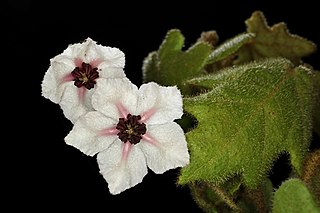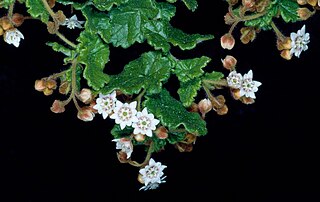
Thomasia is a genus of thirty-one species of flowering plants in the family Malvaceae. Plants in this genus are small shrubs that are endemic to the south-west of Western Australia, apart from T. petalocalyx that is native to Victoria and South Australia. The leaves are simple with leaf-like stipules at the base of the petiole, the flowers bisexual with five papery, petal-like sepals, usually five petals and five stamens opposite the petals. The fruit is a capsule covered with star-like hairs.

Guichenotia is a genus of 17 species of flowering plants in the family Malvaceae that is endemic to the south west of Western Australia. Plants in the genus Guichenotia are shrubs with simple, linear to oblong leaves with leaf-like stipules at the base of the petiole, the flowers bisexual with three bracteoles at the base of the sepals, and five petal-like sepals, the petals sometimes absent. The fruit is a capsule usually containing 15 seeds.

Thomasia tenuivestita is a species of flowering plant in the family Malvaceae and is endemic to the south-west of Western Australia. It is a shrub with its new growth covered with greyish, star-shaped hairs, and has egg-shaped leaves, and racemes of mauve flowers.

Thomasia sarotes is a species of flowering plant in the family Malvaceae. It is an upright, spreading shrub with purple, pink to mauve or white flowers and is endemic to the south-west of Western Australia.

Ricinocarpos pinifolius, commonly known as wedding bush, is a shrub of the family Euphorbiaceae and is endemic to eastern Australia. It has fragrant daisy-like flowers in spring.

Androcalva fraseri, commonly known as blackfellow's hemp or brush kurrajong, is a species of flowering plant in the family Malvaceae and is endemic to eastern Australia. It is a small tree or shrub that forms suckers and has egg-shaped or lance-shaped leaves with serrated edges, and clusters of 13 to 21 white flowers.

Thomasia purpurea is a small, flowering shrub in the family Malvaceae that is endemic to the southwest of Western Australia. It has green oblong-shaped leaves and pinkish purple flowers.

Guichenotia ledifolia is a species of flowering plant in the family Malvaceae and is endemic to the southwest of Western Australia. It is a densely-branched shrub with densely hairy new growth, hairy, linear to oblong leaves and pink to mauve flowers arranged in groups of three to ten.

Thomasia solanacea is a species of flowering plant in the family Malvaceae and is endemic to the south-west of Western Australia. It is an erect, bushy shrub with egg-shaped leaves, the bases heart-shaped, and racemes of white, cream-coloured or pink to purple flowers.

Thomasia angustifolia, commonly known as narrow-leaved thomasia, is a species of flowering plant in the family Malvaceae and is endemic to the south-west of Western Australia. It has densely hairy young stems, narrowly oblong, wrinkled leaves and pinkish-purple, bell-shaped flowers.

Asterolasia correifolia is a species of erect shrub that is endemic to eastern Australia. It has white to brown star-shaped hairs on its stems, lance-shaped to elliptical leaves densely covered with white star-shaped hairs on the lower surface, and white to cream-coloured or yellow flowers arranged in umbels of four to ten or more in leaf axils, the back of the petals densely covered with white hairs.

Thomasia brachystachys is a species of flowering plant in the family Malvaceae and is endemic to the Southwest Australia south-west of Western Australia. It is an open, erect shrub with egg-shaped to heart-shaped leaves and pink to mauve flowers.

Thomasia cognata is a species of flowering plant in the family Malvaceae and is endemic to the south-west of Western Australia. It is a compact, multi-stemmed shrub with wrinkled, narrowly oblong to elliptic leaves and pale pink flowers.
Thomasia dielsii is a species of flowering plant in the family Malvaceae and is endemic to the south-west of Western Australia. It is a low, erect to spreading shrub with egg-shaped leaves with wavy edges, and purple, violet and blue flowers.

Thomasia discolor is a species of flowering plant in the family Malvaceae and is endemic to the south-west of Western Australia. It is a multi-stemmed shrub with densely hairy branchlets, coarsely serrated, egg-shaped leaves with a heart-shaped base, and many small pink, cream-coloured or white flowers.
Thomasia × formosa is a species of flowering plant in the family Malvaceae and is endemic to a restricted area of the south-west of Western Australia. It is an erect, compact shrub with densely hairy branchlets, hairy, coarsely serrated, egg-shaped to elliptic or oblong leaves, and racemes of pink or purple flowers arranged in leaf axils.
Thomasia glabripetala is a species of flowering plant in the family Malvaceae and is endemic to a restricted area of the south-west of Western Australia. It is an open shrub with densely hairy branchlets, sparsely hairy, wrinkled, elliptic or oblong leaves, and racemes of purplish-pink flowers arranged in leaf axils.

Thomasia paniculata, commonly known as few-flowered thomasia, is a species of flowering plant in the family Malvaceae and is endemic to the south-west of Western Australia. It is a slender, erect or straggling shrub with egg-shaped leaves and pink to purple, occasionally white flowers.
Thomasia tremandroides is a species of flowering plant in the family Malvaceae and is endemic to the south-west of Western Australia. It is an erect or low, spreading shrub with many stems, flimsy, papery, egg-shaped leaves and racemes of papery, mauve to pink flowers.

Androcalva gaudichaudii is a species of flowering plant in the family Malvaceae and is endemic to the far west of Western Australia. It is a low, dense shrub that forms suckers and has broadly oval leaves with a heart-shaped base, and clusters of 2 to 11 white flowers.
















